Respiratory Applications
Breathing assessment is an essential part of a Psychophysiological Stress Profile, whether or not a client's presenting complaints are respiratory. Dysfunctional breathing patterns like overbreathing can be caused by underlying medical disorders and contribute to diverse medical and psychological symptoms. The interrelationship between dysfunctional breathing and health makes collaboration with physicians essential.
Healthy breathing is a foundation for successful biofeedback and neurofeedback training. Failure to correct dysfunctional breathing behaviors may limit interventions like heart rate variability biofeedback for asthma or neurofeedback for ADHD.
Clients may find the shift to healthy breathing challenging since dysfunctional breathing is often overlearned and embedded in chronic stress responses. In the case of overbreathing, clients may need reassurance that they receive sufficient oxygen and training to recover their breathing reflex (initiating the next breath when CO2 levels rise).
Shifting to healthy breathing offers immediate benefits in increased ventilation, improved acid-base balance, which results in greater glucose and oxygen delivery to the brain and other organs, and vasodilation of the hands and feet due to increased nitric oxide release. The practice of slow-paced breathing can improve vagal tone, restore a healthy respiratory sinus arrhythmia, and promote homeostasis. Graphic © Pixel-Shot/Shutterstock.com.
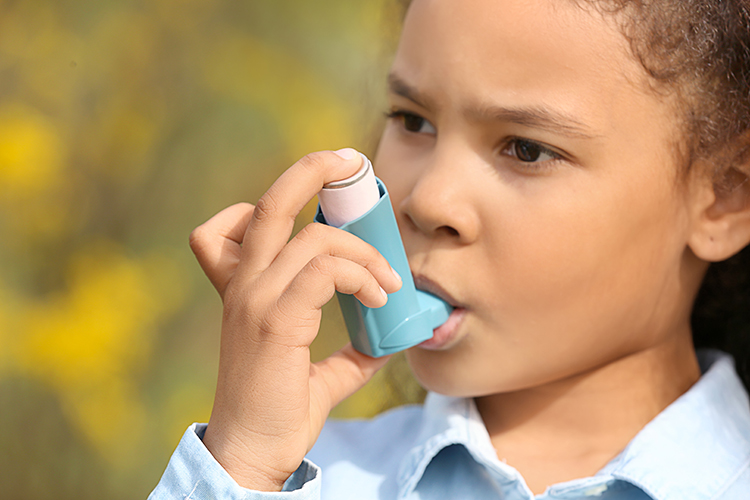
BCIA Blueprint Coverage
This unit addresses the Pathophysiology, biofeedback modalities, and treatment protocols for specific ANS biofeedback applications (IV-D).

This unit covers
Breathing Assessment, Healthy Breathing, Hyperventilation Syndrome, Asthma, and Chronic Obstructive Pulmonary Disease (COPD).
Please click on the podcast icon below to hear a lecture over the first third of this unit.

EVIDENCE-BASED PRACTICE (4TH ED.)
We have updated the efficacy ratings for clinical applications covered in AAPB's Evidence-Based Practice in Biofeedback and Neurofeedback (4th ed.).
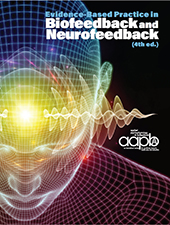
Breathing Assessment
Since overbreathing and hyperventilation can represent attempts to compensate for serious medical problems like kidney disease, a medical investigation is critical before starting respiratory biofeedback. Attempts to restore "normal" end-tidal CO2 levels could endanger client safety by reducing acid buffering.
When overbreathing (end-tidal CO2 below 33 mmHg) is suspected, practitioners can administer the Nijmegen Questionnaire (van Dixhoorn & Folgering, 2015) because it assesses symptoms produced by dysfunctional breathing like blurred vision, confusion, and dizziness.

Clinicians can adapt the Psychophysiological Stress Profile (PSP) described in the Psychophysiology unit for comprehensive breathing assessment. A capnometer should be added to the PSP to evaluate breathing physiology in addition to rate, pattern, and dysfunctional breathing behaviors. Conway (1994) proposed that clients with baseline end-tidal CO2 ≤ 30 mmHg, whose stress or hyperventilation trial end-tidal CO2 decreases 20% or more, or who fails to recover to within 80% of baseline values during a recovery period should receive breath training.
Cautionary Note About Hyperventilation Screening
Click on the Read More button for cautions in hyperventilation screening.
"Breathing rapidly and shallowly, what is commonly called hyperventilation, is a useful stress trial, which often produces a visible physiological stress response and often induces one or more of the patient's presenting symptoms, especially for patients with anxiety disorders. However, deliberate hyperventilation is challenging both subjectively and medically. Practitioners should carefully screen patients and refrain from using the hyperventilation trial when there is a history of pulmonary or heart disorders. Also, each patient should be instructed to cease the rapid breathing if the trial triggers discomfort" (Moss & Shaffer, 2022).
Case Narrative
Click on the Read More button for a case narrative.
"A 53-year-old married woman presented for treatment of panic disorder with agoraphobia. She was unemployed for seven weeks and had not left home since the loss of employment. She reported inactivity, depressive mood, and fearfulness at any suggestion of leaving the home. She reported panic attacks with rapid heart rate, tightness in chest, dizziness, fears of dying. In the first interview, she exhibited breath-holding and shallow breathing. She also reported recurrent episodes with migraine headache and gastro-esophageal reflux disorder. On her physiological baseline, this subject breathed at a moderately rapid rate, but showed normal CO2 levels. She described herself as tense and anxious at being out of her home. She was instructed to relax by breathing slowly and comfortably. She was then instructed to visualize a stressful time, then to relax again. She was given a second stress trial consisting of one minute of rapid breathing. She was then given 3 minutes to recover a relaxed state."

"This patient was only moderately challenged by visualizing a marital argument. She showed a moderate elevation in rate of breathing and a moderate decrease in CO2. But hyperventilation produced a dramatic decrease in CO2 and caused her to blurt out, "This is it; this is my attack, this is just what happens."" She was unable to recover either physiologically or subjectively with a three-minute self-directed recovery. Still, she did recover when the therapist guided her moment to moment in paced diaphragmatic breathing."
"The assessment successfully showed that rapid shallow breathing produced the same anxiety/panic symptoms as leaving the house. It also convinced the patient to commit herself to biofeedback-assisted breath training and cognitive-behavioral therapy (CBT) for anxiety. She improved substantially, with a near-complete cessation of panic attacks after 8 weeks of breath training and CBT."
Healthy Breathing
Common Breathing Misconceptions
At rest, we do not need more oxygen! Near sea level, the air that we inhale contains 21% oxygen, whereas the air we exhale contains 15% oxygen. Graphic © Stephen P. Crane/Shutterstock.com.
We only use one-fourth of inhaled oxygen and don't need more. We need to conserve CO2 by retaining 85-88% of its volume (Khazan, 2021).
Breathing Overview
Healthy breathing achieves a match between metabolic needs, production of CO2, and breath depth and rate. We should maintain optimal breathing chemistry for each activity level and breathing rate. Although rapid breathing does not always signal overbreathing and slow breathing does not always indicate health, there are correlations (Khazan, 2021). Breathing should be mindful with focus on the abdomen, effortless, between 5-7 breaths per minute, supported by loose clothing, posture, and ergonomics that promote healthy breathing.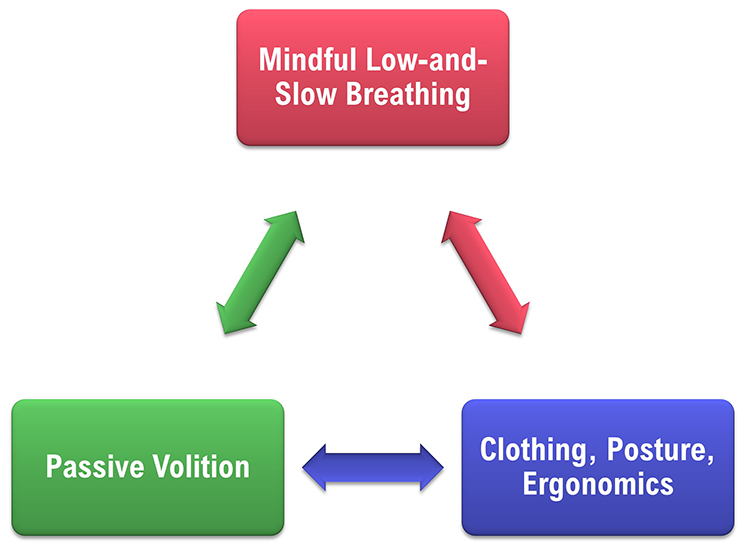
Breathe Effortlessly
Encourage your clients to breathe effortlessly (Peper & Tibbets, 1994) at a comfortable depth (like smelling a flower) and an inhalation-to-exhalation ratio with longer exhalations than inhalations. Breathing will calm your client when its depth and rate satisfy the resting body's metabolic needs (Khazan, 2021). Graphic © David Prado Perucha/Shutterstock.com.
Discourage Deep Breaths
Discourage typical deep breathing, where a client inhales a massive breath and inevitably exhales too quickly because this promotes overbreathing and expels too much CO2 (Khazan, 2021).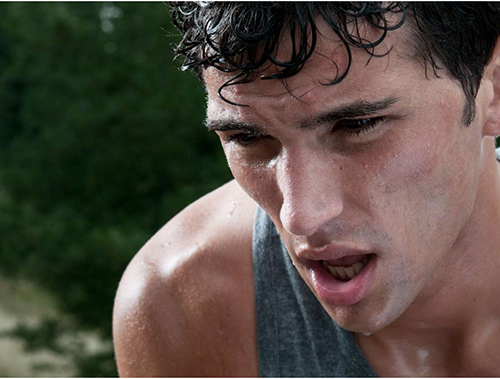
Breathing will calm your client when its depth and rate satisfy the resting body's metabolic needs. Don't encourage deeper or larger breaths. Graphic © Shutterstock.com.

Encourage Clients to Dress for Success
Caution clients to avoid the designer jean syndrome (Peper & Tibbets, 1994) in which tight clothing prevents abdominal expansion and promotes thoracic breathing. Graphic © RStollner/Shutterstock.com.
Practice Breathing Basics
Encourage your clients to inhale through the nostrils to filter, moisten, and warm the air. They should exhale through the mouth or nose depending on training goals and health. Graphic © fizkes/Shutterstock.com.
Great Posture Promotes Healthy Breathing
"Make sure you choose a comfortable chair that allows you to sit with a straight back, the vertebrae of your spine stacked neatly on top of one another. Your feet should be flat on the floor, legs uncrossed, knees at a 90-degree angle" (Lagos, 2020, p. 58). Clients may also enjoy practice in natural settings. Graphic © BalanceFormCreative/Shutterstock.com.
Enhance Your Clients' Respiratory Feedback
Teach your clients to exhale using pursed lips as if blowing out a candle (Khazan, 2021). Graphic © JPRFPhotos/Shutterstock.com.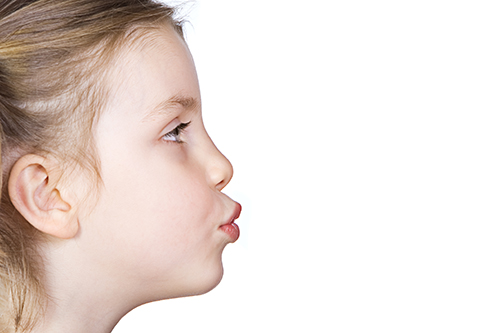
Invite clients to breathe with a weight on the abdomen while lying on the floor with knees bent.
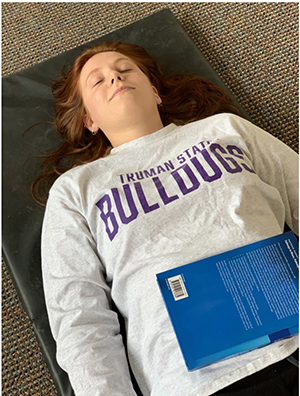
Alternatively, they can place their hands on their abdomens. Graphic Shutterstock.com.
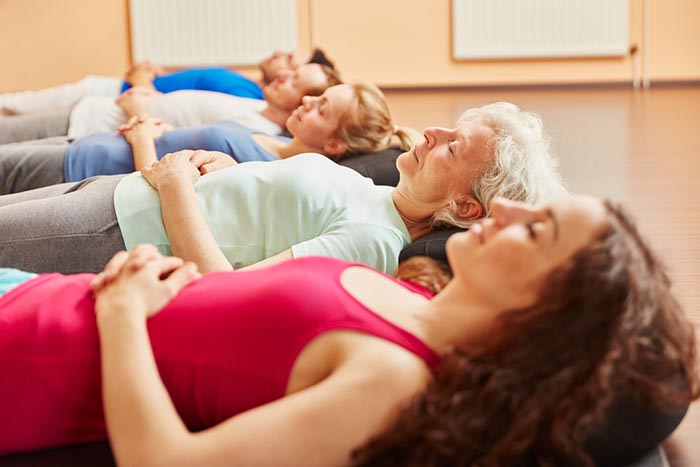
For their safety and your liability, don't encourage clients to use Biofeedback: A Practitioner's Guide (3rd ed.) or an equivalent 20-pound sack of rice.

Help Clients Recover Their Breathing Reflex and Correct Overbreathing
Clients may override the breathing reflex during overbreathing. They inhale too early before CO2 levels rise to the level that triggers the next breath, lowering blood CO2 levels. This “hijacking” of the breathing reflex may represent an attempt to catch one’s breath due to fear of insufficient oxygen or to reduce anxiety (Khazan, 2021).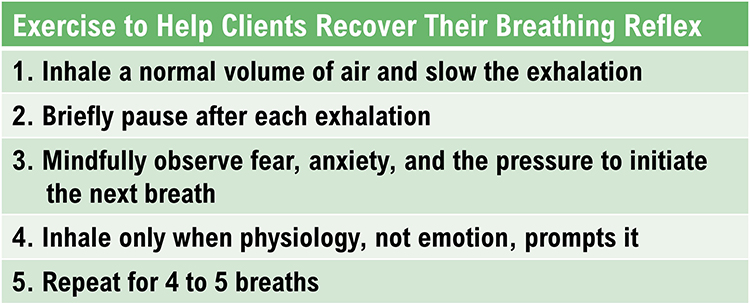
Clients who overbreathe are often unaware of their breathing pattern. We need to teach them to "tune into" to their breathing. They may breathe thoracically and overuse their external intercostal muscles during inhalation. Graphic © Shot4Sell/Shutterstock.com.
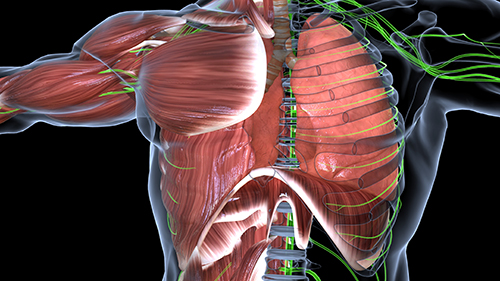
When clients overbreathe, it is vital to help them shift to abdominal breathing so that the dome-shaped diaphragm may descend more completely.
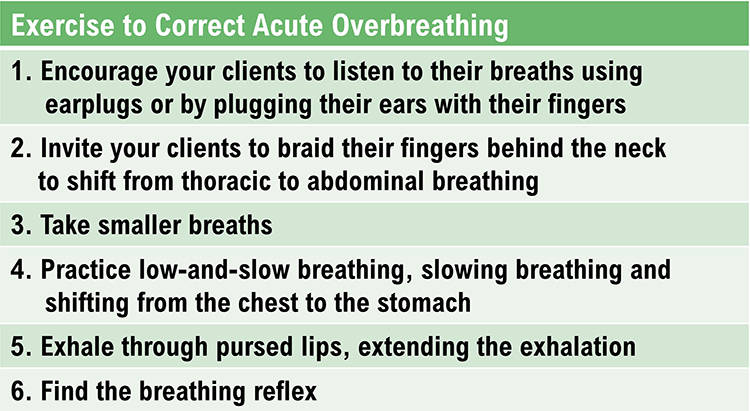
Encourage Practice with Breathing Apps and Breath Pacers
Please click on the podcast icon below to hear a lecture over the second third of this unit.

Breathing Apps
You may use a computer, pad, and smartphone apps that provide auditory or visual pacing. Try them out to find the apps that offer the adjustability and ease of use that will be best for your clients.Consider Coherence Coach and EZ-Air Plus for computers.
 |
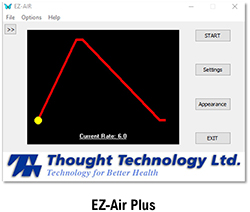 |
Popular apps are available for both Android and Apple platforms.
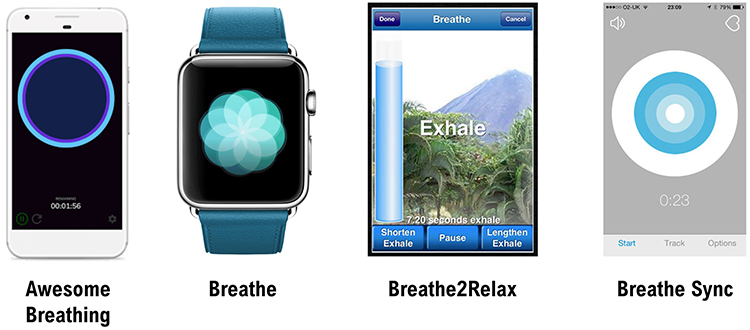
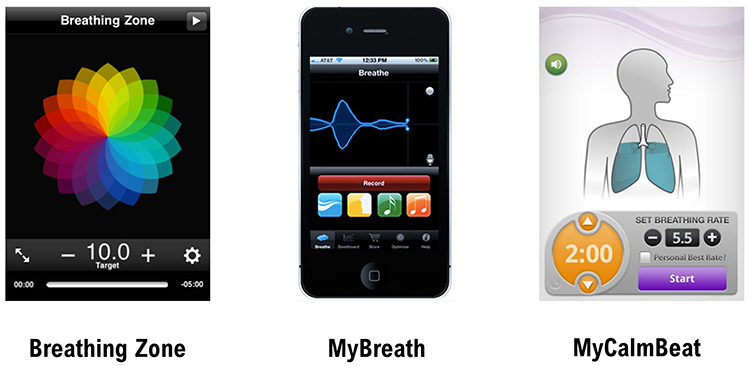
Encourage Practice with Breathing Pacers
Assign practice with breathing pacers and then gradually fade. Click on the Alliant link to download these free tracks.
Healthy Breathing Tips
Peper (1994) and Khazan (2021) have proposed several invaluable breathing suggestions. |
 |

Paced Breathing Demonstration By Dr. Khazan
Dr. Inna Khazan demonstrates how paced and normal breathing can change low- and high-frequency power © Association for Applied Psychophysiology and Biofeedback. You can enlarge the video by clicking on the bracket icon at the bottom right of the screen. When finished, click on the ESC key.
Click on the Read More button for software breathing displays.

The BioGraph ® Infiniti display below shows healthy inhalation and exhalation in which the abdomen gradually expands and then contracts.
The BioTrace+/NeXus-10 training screen below was designed to teach effortless breathing. The balloon's inflation and deflation mirror the respiration sensor's rhythmic expansion and contraction.
Monitor and Discourage Excessive Breathing Effort
Several "red flags" can signal effortful breathing. First, accessory muscle (e.g., trapezius and scalene) SEMG increases. A trapezius-scalene placement is sensitive to breathing effort.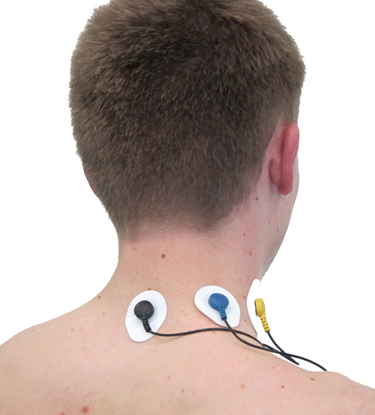
A BioGraph ® Infiniti accessory muscle training screen used to correct clavicular breathing is shown below.
Second, end-tidal CO2 often declines with effort. A capnometer can show whether values fall below 36 mmHg. See the segment from 01:40 to 03:20. Graphic © Inna Khazan.

Third, the respirometer waveform may lose its smoothness when clients try harder.

Physiological Effects of Healthy Breathing
Healthy breathing is an indispensable component of biofeedback-assisted relaxation training (BART) and biofeedback and neurofeedback interventions because it can produce system-wide changes. The increased release of nitric oxide dilates arterioles in the hands and feet, promoting hand-warming. Vasodilation also means that the body can deliver more oxygen and glucose to organs, especially the brain, which is responsible for self-regulation. Graphic adapted from Inna Khazan.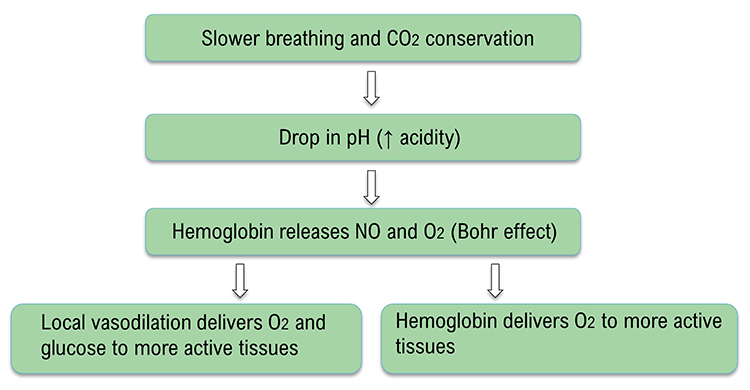
The normalization of end-tidal CO2, coupled with increased vagal tone and endogenous opioid release, can buffer stressors and calm clients. Peripheral vasodilation, critical to the treatment of hypertension, Raynaud's disease, and vascular headache occurs when respiration rate falls below 6 breaths per minute and end-tidal CO2 reaches 5% (36 mmHg; Fried, 1990).
Hyperventilation Syndrome
Hyperventilation syndrome (HVS) has been reconceptualized as a behavioral breathlessness syndrome in which hyperventilation is the consequence and not the cause of the disorder. The traditional model that hyperventilation results in reduced arterial CO2 levels has been challenged by the finding that many HVS patients have normal arterial CO2 levels during attacks (Kern, 2021). Check out the YouTube video Breathing Pattern Disorders such as Hyperventilation. Graphic © Pixel-Shot/Shutterstock.com.
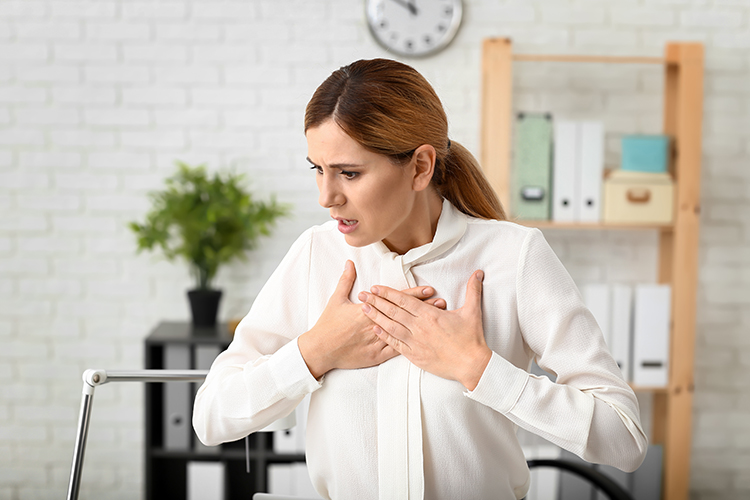
Symptom History
Acute HVS patients are often agitated and anxious. Both acute and chronic HVS patients report a sudden onset of breathing difficulties (e.g., wheezing), chest pain and palpitations that can last for hours, and neurologic complaints (e.g., dizziness, near-syncope or syncope, paresthesias, tetanic cramps, and weakness) following stressful situations (Kern, 2021). Graphic © DruZhi Art/Shutterstock.com.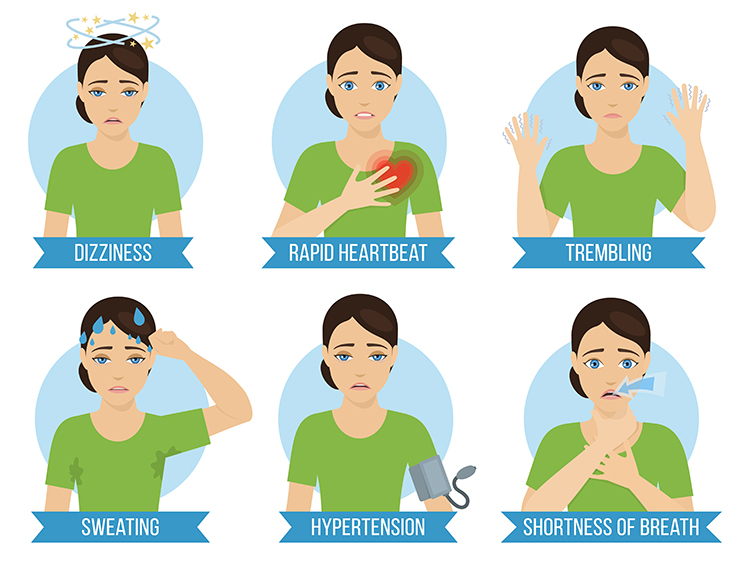
Rapid shallow thoracic breathing is punctuated with effortless sighs and gasps. Hyperventilators interrupt breathing (apnea) when surprised, writing checks, talking, or moving (Fried, 1990; Peper, 1989).
The BioGraph ® Infiniti display below shows the shallow rapid breathing that characterizes hyperventilation.
Demographics
Upwards of 10% of general internal medicine patients have a primary diagnosis of HVS. As many as 6% of the United States population presents with some HVS symptoms. The peak ages for HVS are between 15 and 55 years. The female-to-male ratio may reach 7:1. While HVS and panic disorder are different conditions, their symptoms considerably overlap. About 50% of patients diagnosed with panic disorder and 60% diagnosed with agoraphobia present with hyperventilation. Only 25% of HVS patients are diagnosed with panic disorder (Kern, 2021).Don't Rebreathe in a Paper Bag
Practitioners should not recommend paper bag rebreathing because it can result in hypoxia (insufficient oxygen) and death in heart attack, pneumothorax, and pulmonary embolism patients (Calaham, 1989). Graphic © InfinityPhoto/Shutterstock.com.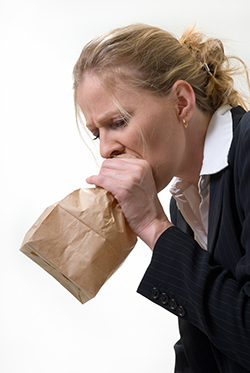
Respiratory Biofeedback
Medical evaluation should rule out medical conditions like kidney disease or pulmonary embolism that can result in HVS. Where assessment reveals psychological causes, cognitive behavior therapy (CBT) should be part of a multimodal intervention since lowering anxiety may reduce HVS symptom frequency (Gibson et al., 2007). HV often is part of an anxiety and panic positive feedback loop. Graphic © desdemona72/Shutterstock.com.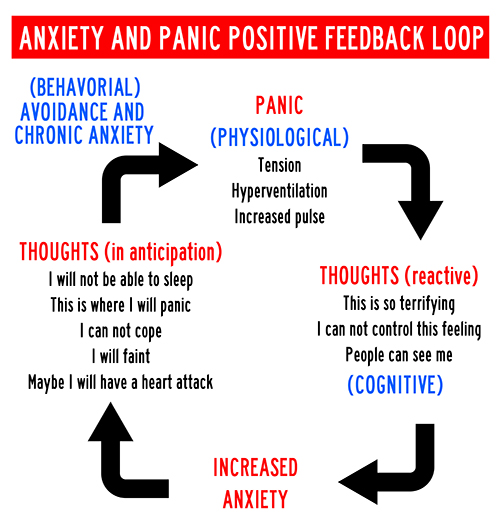
Respiratory biofeedback using a capnometer and respirometer may help teach healthy breathing techniques (Fried, 1987; Khazan, 2021). Graphic © Inna Khazan.

Caption: Fourth training session. Mindful Low-and-Slow Breathing is shown from 00:00 to 03:20, and normal breathing after 03:20.
Asthma
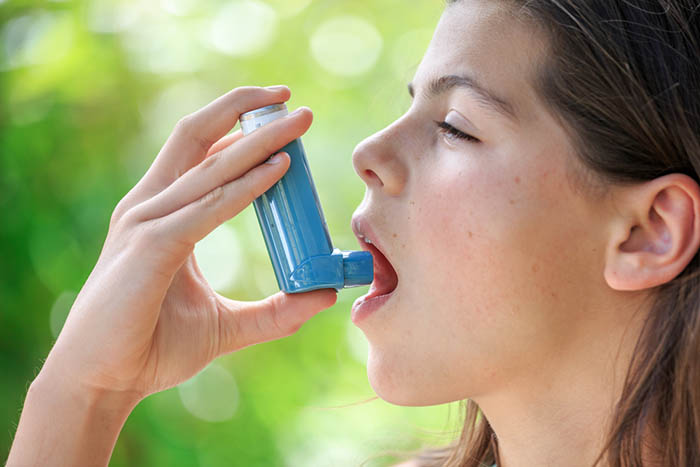
The Global Initiative for Asthma (2018) defined asthma as a "...heterogenous disease, usually characterized by chronic airway inflammation. It is defined by the history of respiratory symptoms, such as wheeze, shortness of breath, chest tightness, and cough that vary over time and in intensity, together with variable expiratory limitation."
Please click on the podcast icon below to hear a lecture over the last third of this unit.

Chronic inflammation produces bronchiole hypersensitivity to stimuli (e.g., allergens, cold air, exercise, and viral infection), airway constriction, and reversible airflow restriction. Check out the Nucleus Medical Media video Asthma at Health Journey Support and the Blausen Asthma animation. Graphic © Alila Medical Media/Shutterstock.com.
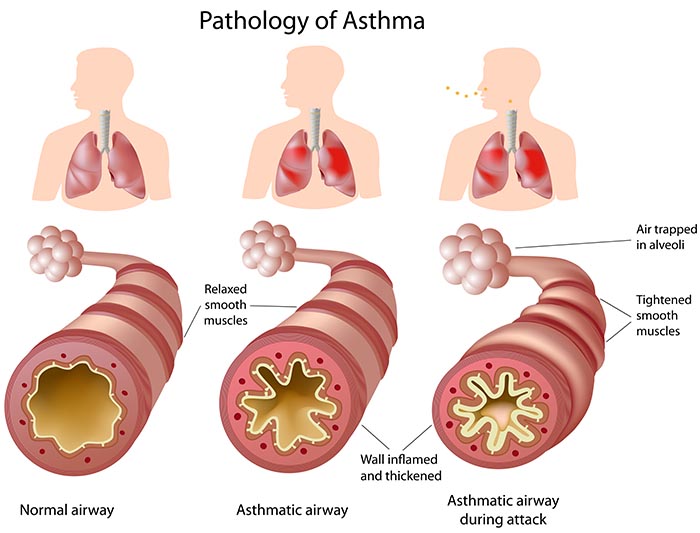
Demographics
While allergens, pollution, infections, exercise, and drugs like aspirin can trigger asthma attacks, both acute and chronic stress can also precipitate asthma attacks in children diagnosed with this disorder. Asthma affects 8.3% of children and 20.4 million adults in the United States (Chronic obstructive pulmonary disease data and statistics, 2017).Asthma prevalence is more pronounced in children, affecting 9.4% of youth, compared to 7.7% in adults. Similarly, it is more common in females, with a prevalence of 9.2%, compared to 7.0% in males (CDC, 2023).Graphic © Designua/Shutterstock.com.
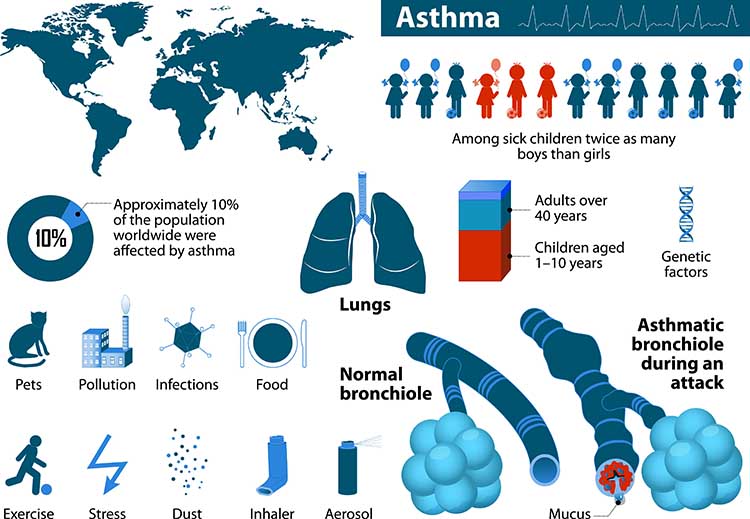
Resonance Frequency Biofeedback for Asthma
Clinicians have used heart variability (HRV) biofeedback with breathing retraining to reduce asthma symptom frequency and severity, improve pulmonary function, and reduce medication use. Lehrer and colleagues' (2000) protocol combines resonance frequency HRV biofeedback with abdominal pursed-lips breathing. The resonance frequency is when maneuvers like paced breathing can stimulate an individual's cardiovascular system to produce the greatest respiratory sinus arrhythmia (RSA).
Biofeedback Studies
Click on the link to review biofeedback asthma studies.
Lehrer et al. (1997) reported a controlled study that showed that RSA biofeedback produced large-scale within-session decreases in respiratory impedance in adults diagnosed with asthma. When they compared RSA biofeedback, neck/trapezius SEMG biofeedback, and incentive inspirometry biofeedback, only the RSA biofeedback group decreased pulmonary impedance (resistance of the bronchioles to airflow).
Kern-Buell, McGrady, Conran, and Nelson (2000) reported that SEMG biofeedback might reduce inflammation and reduce asthma symptoms.
Lehrer, Smetankin, and Potapova (2000) reported that the Smetankin method of respiratory sinus arrhythmia biofeedback reduced asthma symptoms and airway resistance in 20 unmedicated children.
Huntley, White, and Ernst (2002) surveyed controlled studies of relaxation procedures, including SEMG biofeedback, and found no evidence of improved pulmonary function or symptom improvement.
Song and Lehrer (2003) instructed five female volunteers to breathe at respiratory rates of 3, 4, 6, 8, 10, 12, and 14 breaths per minute while they measured HRV amplitude (peak-to-trough HR differences across the breathing cycle). Slower respiration rates produced higher HRV amplitudes. HRV amplitude peaked at 4 breaths per minute and declined at 3 breaths per minute.
Lehrer and colleagues (2004) examined the clinical efficacy of HRV biofeedback in a study of 94 adult asthma patients. After pre-stabilization with controller medication, they randomly assigned these patients to HRV biofeedback with abdominal breathing training, HRV biofeedback alone, placebo EEG biofeedback, or a waiting list control.
Subjects in the two HRV conditions were prescribed less steroid medication and showed improved pulmonary function (measured by forced oscillation pneumography) than control subjects. The two HRV groups did not significantly differ in clinical outcome. All groups showed reduced asthma symptoms and did not differ in the frequency of severe asthma flares. The authors concluded that HRV biofeedback shows promise as an adjunctive treatment for asthma that could reduce reliance on steroid medication.

While Yorke, Fleming, and Shuldham's (2007) Cochrane Systematic Review of 15 studies involving 687 participants could not reach definitive conclusions about the efficacy of psychological interventions due to the limited data, they did find that biofeedback significantly increased forced expiratory volume (FEV1).
Meuret, Ritz, Wilhelm, and Roth (2007) reported that capnometric biofeedback raised end-tidal pCO2 and reduced respiration rate and the frequency and severity of asthma symptoms.
Below is a BioGraph ® Infiniti heart rate variability training screen with a breathing pacer and nature animation from Moss, Shaffer, and White's (2009) Heart Rate Variability Suite.
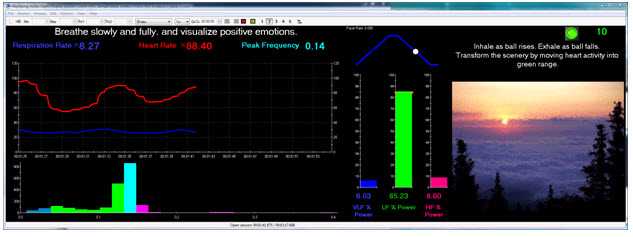
Clinical Efficacy
Based on five RCTs, Paul Lehrer, Gali Moritz, and Naomi Greenfield rated HRV BFB for asthma as level 5 - efficacious and specific in Evidence-Based Practice in Biofeedback and Neurofeedback (4th ed.).Participants improved in asthma severity and symptoms, pulmonary function, and medication use. The impact of HRVB on airway inflammation is uncertain.
Chronic Obstructive Pulmonary Disease (COPD)
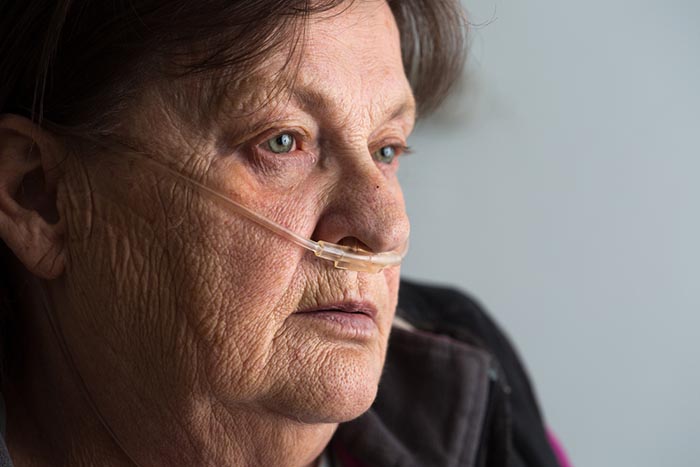
Chronic obstructive pulmonary disease (COPD) is a family of lung diseases that interfere with airflow. The Global Initiative for Chronic Obstructive Lung Disease (2019) definite it as "...a common preventable and treatable disease characterized by persistent airflow limitation that is usually progressive and associated with an enhanced chronic inflammatory response in the airways and the lung to noxious particles or gases."
COPD is a progressive disorder, and almost 50% of severe cases die within 10 years of initial diagnosis. Chronic obstructive bronchitis and emphysema comprise COPD. Check out the Nucleus Medical Media video Chronic Obstructive Pulmonary Disease at Health Journey Support and the Blausen COPD animation. Graphic © Alila Medical Media/Shutterstock.com.
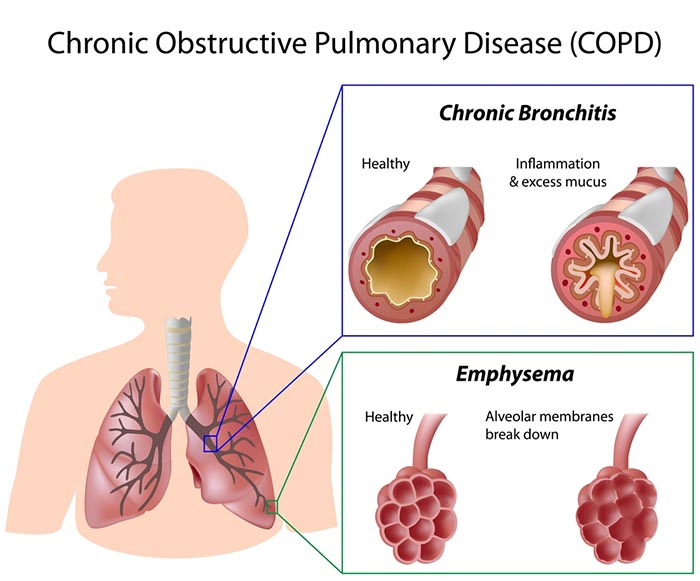
Chronic bronchitis involves mucus hypersecretion and chronic productive cough for at least 3 months for a minimum of 2 consecutive years (Huether & McCance, 2020). Graphic © Antonov Maxim/Shutterstock.com.
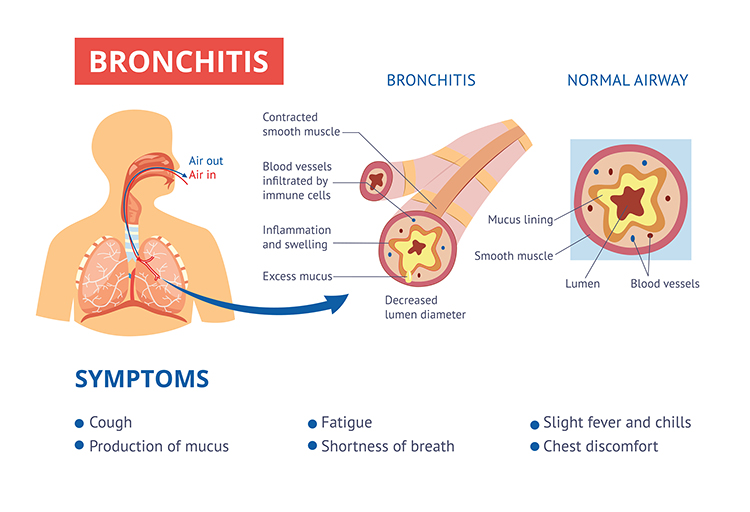
In emphysema, abnormal irreversible expansion of the gas-exchange airways is associated with alveolar wall damage (Huether & McCance, 2020). Unlike chronic bronchitis, inflammation and lung damage produce obstruction instead of mucus buildup. The surviving air sacs are larger and are less able to exchange gas. Graphic © Alila Medical Media/Shutterstock.com.
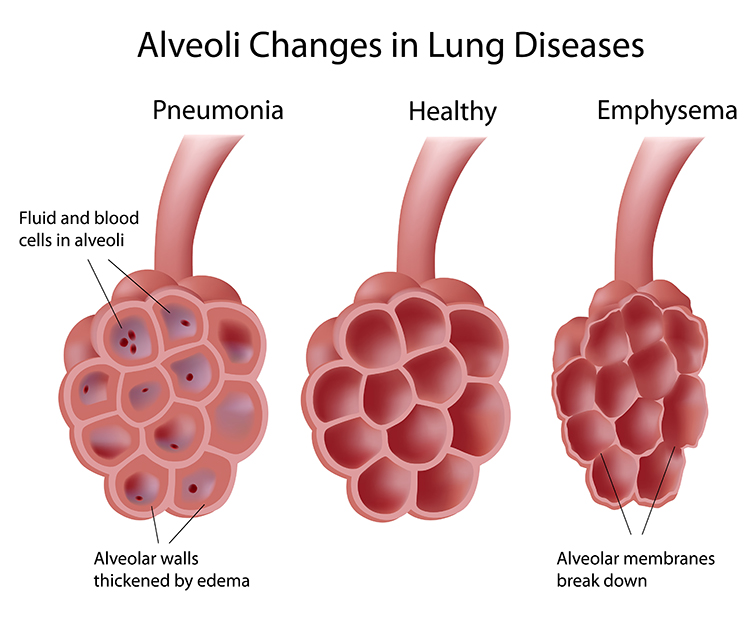
Demographics
COPD may affect 32 million patients in the United States and is the fourth leading cause of death. Patients are often diagnosed with chronic bronchitis and emphysema, and the classic triad adds asthma (Kleinschmidt, 2020).Multimodal Interventions
Clinicians combine HRV biofeedback with exercise and paced breathing instruction to increase ventilation and exercise tolerance.Biofeedback Studies
Esteve and colleagues (1996) randomly assigned participants to either breathing pattern training or a control group. The group that received respiratory training increased FEV1 (forced expiratory volume in one second) 22% and FVC (forced vital capacity) by 19%, while the control group did not improve.Giardino and colleagues (2004) treated COPD with a combination of HRV biofeedback and exercise. Ten participants received five HRV biofeedback sessions to increase HRV combined with paced breathing instruction. They also walked four times a week, using their paced respiration skills to control breathing. They checked their oxygen levels using an oximeter. These patients improved on the six-minute walking distance test (6MWD), which measures functional capacity, and the St. George's Respiratory Questionnaire (SGRQ), which assesses the overall quality of life. Eight of these participants achieved clinically significant gains on these measures.
Clinical Efficacy
Based on eight RCTs, Christopher Gilbert (2023) rated biofeedback for COPD as level 3 - probably efficacious in Evidence-Based Practice in Biofeedback and Neurofeedback (4th ed.). This rating was due to limitations in study design and sample size.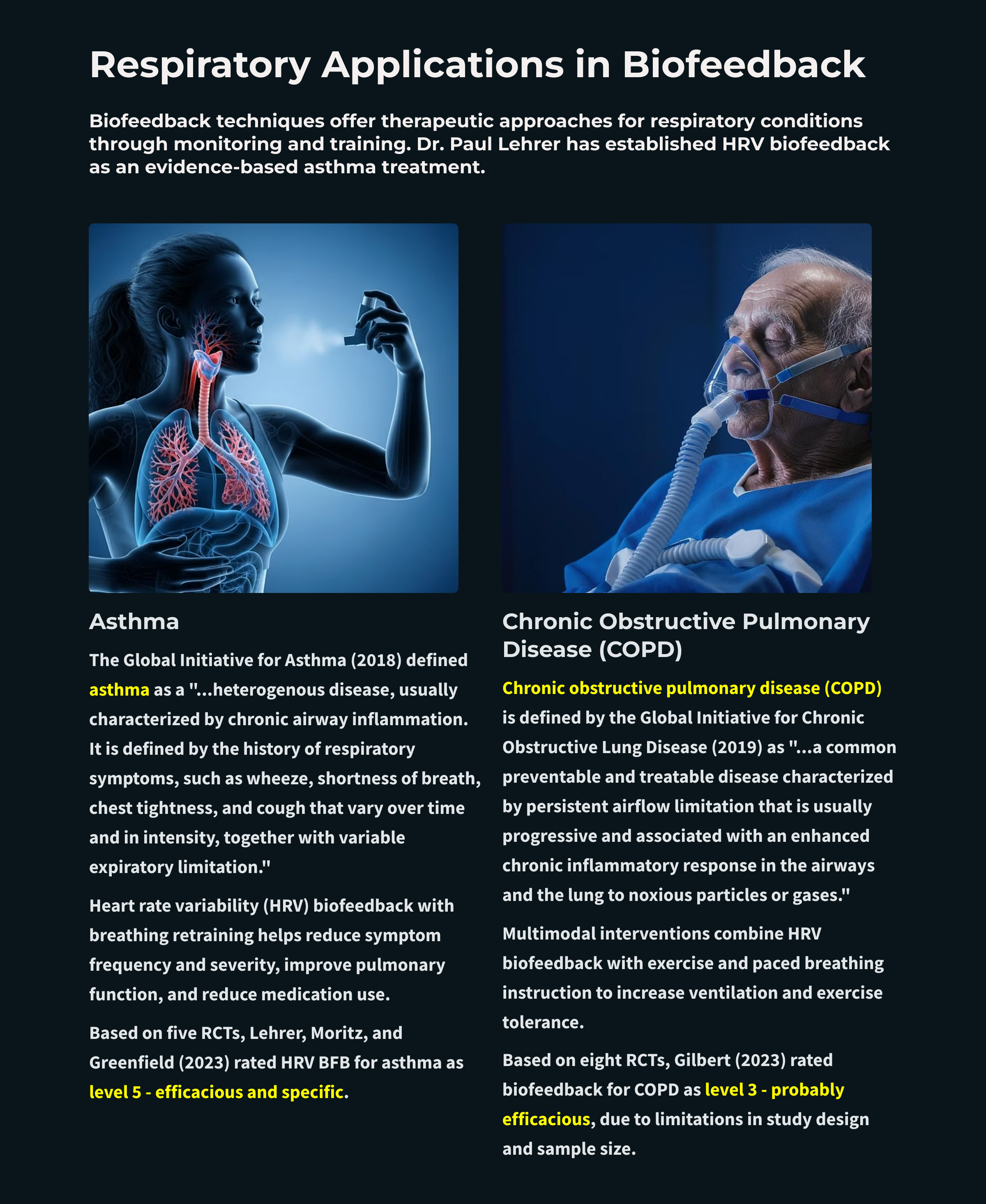
Glossary
accessory muscles: sternocleidomastoid, pectoralis minor, scalene, and trapezius muscles, used during forceful breathing, and clavicular and thoracic breathing.
asthma: episodic reversible airway obstruction, chronic airway inflammation, and hypersensitivity to stimuli (like allergens, cold air, exercise, and viral infection). Chronic inflammation may scar the airway resulting in obstruction that does not reverse with medication.
behavioral breathlessness syndrome: the perspective that hyperventilation is the consequence and not the cause of the disorder. Emergency room data contradict the model that hyperventilation results in reduced arterial CO2 levels. Many HVS patients have normal arterial CO2 levels during attacks.
Bohr effect: elevated blood pH causes hemoglobin to tightly bind oxygen, slowing oxygen release to body tissues and reducing the partial pressure of oxygen (PO2).
capnometer: an instrument that monitors the carbon dioxide (CO2) concentration in an air sample (end-tidal CO2) by measuring the absorption of infrared light.
cardiovascular resonance frequency biofeedback: Lehrer and colleagues’ Smetankin protocol combines HRV biofeedback with abdominal pursed-lips breathing. They train patients to breathe at their resonance frequency to increase HRV and treat disorders like asthma.
chronic obstructive pulmonary disease (COPD): a progressive respiratory disorder that is mainly caused by smoking tobacco. Additional causes include cystic fibrosis, alpha-1 antitrypsin deficiency, bronchiectasis (chronic abnormal bronchiole dilation), and rare bullous lung diseases (featuring thin-walled sacs that contain air).
diaphragm: dome-shaped muscle whose contraction enlarges the chest cavity's vertical diameter and accounts for about 75% of air movement into the lungs during relaxed breathing.
effortless breathing: Peper’s relaxed breathing method in the client uses about 70% of maximum effort, attention settles below the waist, and the volume of air moving through the lungs increases. The subjective experience is that "my body breathes itself."
end-tidal CO2: the percentage of CO2 in exhaled air at the end of exhalation.
high-frequency (HF) or respiratory band: the ECG frequency range from 0.15-0.40 Hz represents the inhibition and activation of the vagus nerves by breathing at average rates.
histamine: biogenic amine that is often released during allergic reactions to food, reducing blood oxygen saturation by constricting vessels and directly affecting red blood cell transport of oxygen. Histamine may cause hyperventilation.
hyperventilation syndrome (HVS): respiratory disorder that has been increasingly reconceptualized as a behavioral breathlessness syndrome in which hyperventilation is the consequence and not the cause of the disorder. Emergency room data contradict the model that hyperventilation results in reduced arterial CO2 levels. Many HVS patients have normal arterial CO2 levels during attacks.
low-frequency (LF) band: the ECG frequency range of 0.05-0.15 Hz that represents the influence of the parasympathetic branch and blood pressure regulation by baroreceptors.
metabolic acidosis: pH imbalance in which the body has accumulated excessive acid and has insufficient bicarbonate to neutralize its effects. In diabetes and kidney disease, hyperventilation is an attempt to compensate for abnormal acid-base balance. Slower breathing could endanger health.
modeling effect: a therapist's breathing behaviors influence patient breathing.
pulmonary impedance: resistance of the bronchioles of the lungs to airflow, which is increased in asthma.
pulse oximeter: a device that measures dissolved oxygen in the bloodstream using a photoplethysmograph sensor placed against a finger or earlobe.
rectus abdominis: muscle of forceful expiration that depresses the inferior ribs and compresses the abdominal viscera to push the diaphragm upward.
resonance frequency: frequency at which a system, like the cardiovascular system, can be activated or stimulated; breathing rate that maximizes the most time-domain measurements of heart rate variability.
respiratory sinus arrhythmia (RSA): heart rate acceleration during inspiration and deceleration during expiration.
reverse breathing: the abdomen expands during exhalation and contracts during inhalation, often resulting in incomplete ventilation of the lungs.
tidal volume: the volume of air moved in and out of lungs with each breath during ordinary effort.
torr: unit of atmospheric pressure, named after Torricelli, that equals a millimeter of mercury (mmHg) and is used to measure end-tidal CO2.
trapezius-scalene placement: active SEMG electrodes are located on the upper trapezius and scalene muscles to measure respiratory effort.
Test Yourself
Click on the ClassMarker logo to take 10-question tests over this unit without an exam password.

REVIEW FLASHCARDS ON QUIZLET
Click on the Quizlet logo to review our chapter flashcards.

Visit the BioSource Software Website
BioSource Software offers Human Physiology, which satisfies BCIA's Human Anatomy and Physiology requirement, and Biofeedback100, which provides extensive multiple-choice testing over BCIA's Biofeedback Blueprint.

Assignment
Now that you have completed this module, describe how you assess breathing, the way you integrate breathing training with biofeedback, and your favorite training hints.
References
Calaham, M. (1989). Hypoxic hazards of traditional paper bag rebreathing in hyperventilating patients. Ann Emerg Med, 18(6), 622-628. https://doi.org/10.1016/S0196-0644(89)80515-3
Centers for Disease Control and Prevention (2018). Chronic obstructive pulmonary disease data and statistics. https://www.cdc.gov/copd/data.html
Conway, A. (1994). Breathing and feeling: Capnometry and the individually meaningful psychological stressor. Biofeedback and Self-Regulation, 19(2), 135-139. https://doi.org/10.1007/bf01776486
Cowan, M. J., Pike, K. C., & Budzynski, H. K. (2001). Psychosocial nursing therapy following sudden cardiac arrest: Impact on two-year survival. Nursing Research, 50, 68-76. https://doi.org/10.1097/00006199-200103000-00002
Del Pozo, J., Gevirtz, R., Scher, B., & Guarneri, E. (2004). Biofeedback treatment increases heart rate variability in patients with known coronary artery disease. American Heart Journal, 147, E11. https://doi.org/10.1016/j.ahj.2003.08.013
Elliot, W. J., Izzo, J. L., Jr., White, W. B., Rosing, D. R., Snyder, C. S., Alter, A., Gavish, B., & Black, H. R. (2004). Graded blood pressure reduction in hypertensive outpatients associated with use of a device to assist with slow breathing. Journal of Clinical Hypertension, 6, 553-561. https://doi.org/10.1111/j.1524-6175.2004.03553.x
Esteve, F., Blanc-Gras, N., Gallego, J., & Benechetrit, G. (1996). The effects of breathing pattern training on ventilatory function in patients with COPD. Biofeedback and Self-regulation, 21(4), 311-321. https://doi.org/10.1007/bf02214431
Fox, I., & Rompolski, K. (2022). Human physiology (16th ed.). McGraw Hill.
Fried, R. (1987). The hyperventilation syndrome: Research and clinical treatment. John Hopkins University Press.
Giardino, N. D., Chan, L., & Borson, S. (2004). Combined heart rate variability and pulse oximetry biofeedback for chronic obstructive pulmonary disease: preliminary findings. Applied Psychophysiology and Biofeedback, 29(2), 121-133. https://doi.org/10.1023/b:apbi.0000026638.64386.89
Gibson, D., Bruton, A., Lewith, G. T., & Mullee, M. (2007). Effects of acupuncture as a treatment for hyperventilation syndrome: A pilot, randomized crossover trial. The Journal of Alternative and Complementary Medicine, 13(1). https://doi.org/10.1089/acm.2006.5283
Gilbert, C. (2012). Pulse oximetry and breathing training. Biofeedback, 40(4), 137-141. https://doi.org/10.5298/1081-5937-40.4.04
Gilbert, C. (2023). Chronic obstructive pulmonary disease (COPD). In I. Khazan, F. Shaffer, D. Moss, R. Lyle, & S. Rosenthal (Eds). Evidence-based practice in biofeedback and neurofeedback (4th ed.). Association for Applied Psychophysiology and Biofeedback.
Global Initiative for Asthma (2018). Global strategy for asthma management and prevention. https://ginasthma.org/wp-content/uploads/2018/04/wms-GINA-2018-report-tracked_v1.3.pdf.
Global Initiative for Chronic Obstructive Lung Disease (2019). Global strategy for the diagnosis, management, and prevention of COPD 2019 report. https://goldcopd.org/wp content/uploads/2018/11/GOLD-2019-v1.7-FINAL-14Nov2018-WMS.pdf.
Grant, J., Wally, C., & Truitt, A. (2010). The effects of Kargyraa throat-singing and singing a fundamental note on heart rate variability [Abstract]. Poster presented at the meeting of the Biofeedback Foundation of Europe, Rome, Italy.
Hassett, A. L., Radvanski, D. C., Vaschillo, E. G., Vaschillo, B., Sigal, L. H., Karavidas, M. K., . . . Lehrer, P. M. (2007). A pilot study of the efficacy of heart rate variability (HRV) biofeedback in patients with fibromyalgia. Applied Psychophysiology and Biofeedback, 32, 1-10.
Huether, S. E., & McCance, K. L., and Brashers, V. L. (2020). Understanding pathophysiology (7th ed.). Mosby.
Huikuri, H. V., & Makikallio, T. H. (2001). Heart rate variability in ischemic heart disease. Autonomic Neuroscience: Basic and Clinical, 90, 95-101.
Humphreys, P., & Gevirtz, R. (2000). Treatment of recurrent abdominal pain: components analysis of four treatment protocols. Journal of Pediatric Gastroenterology and Nutrition, 31, 47-51. https://doi.org/10.1097/00005176-200007000-00011
Huntley, A., White, A. R., & Ernst, E. (2002). Relaxation therapies for asthma: A systematic review. Thorax, 57(2), 127-131. https://doi.org/10.1136/thorax.57.2.127
Jones, D., Fuller, J., Wally, C., Carrell, D., Peterson, J., Ward, A., Westermann-Long, A., Korenfeld, D., Burklund, Z., Shepherd, S., Francisco, A., Kane, A., & Zerr, C. (2012). Can Ujjayi breathing increase the effectiveness of 6-bpm heart rate variability training? [Abstract]. Applied Psychophysiology and Biofeedback, 37(4), 297-298.
Kabins, A., Goedde, J., Layne, B., & Grant, J. (2008). Brief coaching increases inhalation volume [Abstract]. Applied Psychophysiology and Biofeedback, 33(3), 174.
Karavidas, M. K., Lehrer, P. M., Vaschillo, E. G., Vaschillo, B., Marin, H., Buyske, S., Mlainovsky, D., Radvanski, D., & Hassett, A. (2007). Preliminary results of an open label study of heart rate variability biofeedback for the treatment of major depression. Applied Psychophysiology and Biofeedback, 32, 19-30. https://doi.org/10.1007/s10484-006-9029-z
Kern, B. (2021). Hyperventilation syndrome treatment & management. eMedicine. Retrieved from Medscape. https://emedicine.medscape.com/article/807277-treatment
Kern-Buell, C. L., McGrady, A. V., Conran, P. B., & Nelson, L. A. (2000). Asthma severity, psychophysiological indicators of arousal, and immune function in asthma patients undergoing biofeedback-assisted relaxation. Applied Psychophysiology and Biofeedback, 25(2), 79-91. https://doi.org/10.1023/a:1009562708112
Kleiger, R. E., Miller, J. P., Bigger, J. T., Jr., & Moss, A. J. (1987). Decreased heart rate variability and its association with increased mortality after acute myocardial infarction. American Journal of Cardiology, 59, 256-262. https://doi.org/10.1016/0002-9149(87)90795-8
Kleinschmidt, P. (2020) Chronic obstructive pulmonary disease (COPD) and emphysema in emergency medicine. Medscape. https://emedicine.medscape.com/article/807143-overview
Lagos, L., Vaschillo, E., Vaschillo, B., Lehrer, P., Bates, M., & Pandina, R. (2011). Virtual reality-assisted heart rate variability biofeedback as a strategy to improve golf performance: A case study. Biofeedback, 39(1), 15-20. https://doi.org/10.5298/1081-5937-39.1.11
LaVaque, T. J., Hammond, D. C., Trudeau, D., Monastra, V., Perry, J., Lehrer, P., Matheson, D., & Sherman, R. (2002). Template for developing guidelines for the evaluation of the clinical efficacy of psychophysiological interventions. Applied Psychophysiology and Biofeedback, 27(4), 273-281. https://dx.doi.org/10.1023%2FA%3A1021061318355
Lehrer, P., Carr, R. E., Smetankine, A., Vaschillo, E., Peper, E., Porges, S., Edelberg, R., Hamer, R., & Hochron, S. (1997). Respiratory sinus arrhythmia versus neck/trapezius EMG and incentive inspirometry biofeedback for asthma: A pilot study. Applied Psychophysiology and Biofeedback, 22(2), 95-109). https://doi.org/10.1023/a:1026224211993
Lehrer, P., Smetankin, A., & Potapova, T. (2000). Respiratory sinus arrhythmia biofeedback therapy for asthma: a report of 20 unmedicated pediatric cases using the Smetankin method. Applied Psychophysiology and Biofeedback, 25(3), 193-200. https://doi.org/10.1023/a:1009506909815
Lehrer, P. M. (2007). Biofeedback training to increase heart rate variability. In P. M. Lehrer, R. M. Woolfolk, & W. E. Sime (Eds.). Principles and practice of stress management (3rd ed.). The Guilford Press.
Lehrer, P., Moritz, G., & Greenfield, N. (2023). Asthma. In I. Khazan, F. Shaffer, D. Moss, R. Lyle, & S. Rosenthal (Eds). Evidence-based practice in biofeedback and neurofeedback (4th ed.). Association for Applied Psychophysiology and Biofeedback.
Lehrer, P. M., Vaschillo, E., & Vaschillo, B. (2000). Resonant frequency biofeedback training to increase cardiac variability: Rationale and manual for training. Applied Psychophysiology and Biofeedback, 25(3), 177-191.
Lehrer, P. M., Vaschillo, E., Vaschillo, B., Lu, S., Scardella, A., Siddique, M., & Habib, R. H. (2004). Biofeedback treatment for asthma. Chest, 126, 352-361. https://doi.org/10.1378/chest.126.2.352
Lucini, D., Milani, R. V., Constantino, G., Lavie, C. J., Porta, A., & Pagani, M. (2002). Effects of cardiac rehabilitation and exercise training on autonomic regulation in patients with coronary artery disease. American Heart Journal, 143, 977-983. https://doi.org/10.1067/mhj.2002.123117
McGrady, A., & Moss, D. (2013). Pathways to illness, pathways to health. Springer.
Mancia, G., Ludbrook, J., Ferrari, A., Gregorini, L., & Zanchetti, A. (1978). Baroreceptor reflexes in human hypertension. Circulation Research, 43, 170-177. https://doi.org/10.1161/01.RES.43.2.170
Meuret, A. E., Ritz, T., Wilhelm, F. H., & Roth, W. T. (2007). Targeting pCO2 in asthma: Pilot evaluation of capnometry-assisted breathing training. Applied Psychophysiology and Biofeedback, 32(2), 99-109. https://doi.org/10.1161/01.RES.43.2.170
Mosenifar, Z. (2014). Chronic obstructive pulmonary disease. eMedicine.
Moss, D. (2004). Heart rate variability (HRV) biofeedback. Psychophysiology Today, 1, 4-11.
Mosenifar, Z. (2014). Chronic obstructive pulmonary disease. eMedicine.
Peper, E., Gibney, K. H., Tylova, H., Harvey, R., & Combatalade, D. (2008). Biofeedback mastery: An experiential teaching and self-training manual. Association for Applied Psychophysiology and Biofeedback.
Peper, E., & Tibbetts, V. (1992). Fifteen-month follow-up with asthmatics utilizing EMG/incentive inspirometer feedback. Biofeedback and Self-Regulation, 17(2), 143-151. https://doi.org/10.1007/bf01000104
Sandberg, S., Paton, J. Y., Ahola, S., McCann, D. C., McGuinness, D., Hillary, C. R., & Oja, H. (2000). The role of acute and chronic stress in asthma attacks in children. Lancet, 356, 982-987. https://doi.org/10.1016/s0140-6736(00)02715-x
M. S. Schwartz, & F. Andrasik (Eds.). (2003). Biofeedback: A practitioner's guide (3rd ed.). The Guilford Press.
Shaffer, F., Bergman, S., & Dougherty, J. (1998). End-tidal CO2 is the best Indicator of breathing effort [Abstract]. Applied Psychophysiology and Biofeedback, 23(2).
Shaffer, F., Bergman, S., & Henson, M. (1998). Description of the Truman breathing assessment protocol [Abstract]. Applied Psychophysiology and Biofeedback, 23(2).
Shaffer, F., Bergman, S., & White, K. (1997). Indicators of diaphragmatic breathing effort [Abstract]. Applied Psychophysiology and Biofeedback, 22(2), 145.
Shaffer, F., Knight, D., Sponsel, M., Belcher, J., et al. (1993). Vigilance reduces inhalation volume: Nintendo play may reinforce dysfunctional breathing [Abstract]. Biofeedback and Self-Regulation, 18(3).
Shaffer, F., Mayhew, J., Bergman, S., Dougherty, J., & Irwin, D. (1999). Designer jeans increase breathing effort [Abstract]. Applied Psychophysiology and Biofeedback, 24(2), 124-125.
Shaffer, F., & Moss, D. (2006). Biofeedback. In Y. Chun-Su, E. J. Bieber, & B. Bauer (Eds.). Textbook of complementary and alternative medicine (2nd ed.). Informa Healthcare.
Song, H., & Lehrer, P. M. (2003). The effects of specific respiratory rates on heart rate and heart rate variability. Applied Psychophysiology and Biofeedback, 28(1), 13-23. https://doi.org/10.1023/a:1022312815649
Stein, P. K., Ehsani, A. A., Domitrovich, P. P., Kleiger, R. E., & Rottman, J. N. (1999). Effect of exercise training on heart rate variability in healthy older adults. Am Heart J., 138 (3 Pt 1), 567-76. https://doi.org/10.1016/s0002-8703(99)70162-6
Swanson, K. S., Gevirtz, R. N., Brown, M., Spira, J., Guarneri, E., & Stoletniy, L. (2009). The effect of biofeedback on function in patients with heart failure. Applied Psychophysiology and Biofeedback, 34(2), 71-91. https://doi.org/10.1007/s10484-009-9077-2
Tan, G., Dao, T. K., Farmer, L., Sutherland, R. J., & Gevirtz, R. (2010). Heart rate variability (HRV) and posttraumatic stress disorder (PTSD): A pilot study. Applied Psychophysiology and Biofeedback. https://doi.org/10.1007/s10484-010-9141-y
Tortora, G. J., & Derrickson, B. H. (2021). Principles of anatomy and physiology (16th ed.). John Wiley & Sons, Inc.
Weil. C. M., Wade, S. L., Bauman, L. J., Lynn, H., Mitchell, H., & LaVigne, J. (1999). The relationship between psychosocial factors and asthma morbidity in inner-city children with asthma. Pediatrics, 104, 1274-1280. https://doi.org/10.1542/PEDS.104.6.1274
Wheat, A. L., & Larkin, K. T. (2010). Biofeedback of heart rate variability and related physiology: A critical review. Applied Psychophysiology and Biofeedback, 35(3), 229-242. https://doi.org/10.1007/s10484-010-9133-y
Wise, R. A. (2014). Chronic obstructive pulmonary disease (COPD). The Merck manual.
Yorke, J., Fleming, S. L., & Shuldham, C. M. (2006). Psychological interventions for adults with asthma. Cochrane Database of Systematic Reviews, (1), CD002982. https://doi.org/10.1002/14651858.cd002982.pub3
Zucker, Y. L., Samuelson, K. W., Muench, F., Greenberg, M. A., & Gevirtz, R. N. (2009). The effects of respiratory sinus arrhythmia biofeedback on heart rate variability and posttraumatic stress disorder symptoms: A pilot study. Applied Psychophysiology and Biofeedback, 34(3), 135-143. https://doi.org/10.1007/s10484-009-9085-2